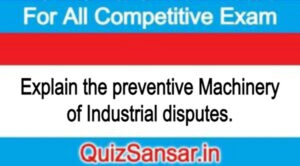
Explain the preventive Machinery of Industrial disputes.
Explain the preventive Machinery of Industrial disputes.
Or
Write short note on the functions of works committee.
Ans.
Methods of prevention of the industrial disputes are explained such as-
(1) Trade Union: Strong Trade Unions helps prevent industrial disputes. They can bargaining with employers effectively and seek quick redressal of grievances. Industrial relation will be sound only when the bargaining power of the employees unions is equal to that of management. A strong union can protect the employees interest relating to wages, benefits, job security etc.
(2) Joint Consultation: To prevent industrial disputes, two ways of joint consultation are adopted (A) work committees and (B) Joint Management Councils.
(A) Work Committees: Works committees have to be set up in all those industrial units which employ 100 or more persons and are composed of an equal number of employer’s and employees representatives. The committee are given the responsibility of removing the causes of friction between workers and management in the day to day functioning of a unit. A works committee is a purely consultative body and not a negotiating body, the functions of a committee is given below:
(i) Greater participation to worker in day to day affairs.
(ii) Ensures close mutual interaction between labor and management.
(iii) Generate a Co-operative atmosphere for negotiation between the two parties.
(iv) Open the door for unions to have a clear view of what is going on with in the unit.
(v) Strengthens the spirit of statutory settlement of the dispute.
A number of issues come under the preview of work committee like wages, benefits, bonus, hours of work, terms and conditions of employment welfare measures, training, transfer etc.
The Tata Iron and Steel Company was the first to create a works committee in 1920. Till the end of Second World war, Employers have not realised to importance of works committees and as a result very few works committees came into existence. The Industrial Dispute Act legalised the establishment of works committees at the plant level.
Works committees in India did not succeed on account of several reasons. The scope and functions of these committees mere not clearly defined. The advisory nature of the committee did not help matters. In the absence of legal power, the committee could not enforce its own decisions. Multiple Unions had their representatives in the same committee at the plant level. This had only escalated tensions among members.
According to the National council on labor the advisory nature of works committees, the recommendations, vagueness regarding their exact scope, their functions, inter union revalries, union apposition to utilise such media have rendered work committees ineffective.
(B) Joint Management Councils: In the Industrial Policy Resolution 1956, the need for joint management councils consisting of representatives of management, technician’s and workers was emphasised. Management must supply facts regarding the working of a unit and the council discussed various matters across the table and recommends steps for improving efficiency.
Originally the idea was to implemented in over 150 units but at present about 80 are operating in public sectors units such as Hindustan Insecticides, HMT, Indian Airlines, Air India etc and in a large number of private sector such as Arvind Mills, Modi spinners and Wearing mills, Travancore Rubber works etc. The experiment has not succeeded in India. The features of this scheme given below:
(i) The joint management councils should consist of equal numbers of representatives of workers and employers minimum number is 6 and maximum 12 members.
(ii) The Joint Management Councils should not encroach on the jurisdiction of works committees.
(iii) The Joint Management Councils members should be given proper training.
(iv) Representation of workers to the JMCs should be based on nominations by the recognised union.
(v) JMCs should be constituted in a large number of public and private sector units being over 500 or more workers where there is a strong trade union, and where the labor management relations are sound.
(vi) JMCs should look after the matters relating to welfare, safety, training, holiday schedules, formulation of standing orders etc. negotiations without the interference of an outside agency. The principles regulating the conduct of the employer and the employee, as provided for in the code, may be listed as:
Obligation of both parties –
(i) It restrain both employers and employees from unilateral action. Both parties must recognize each other rights and obligations and settle disputes through the existing machinery for the settlement of disputes.
(ii) The parties should not indulge in strikes and lockouts without notice or without exploring possibilities to resolve disputes through negotiations.
(iii) Neither party will resort to coercion, intimidation, victimisation or litigation or adopt unfair labor practices that is sit down strike, go slow etc.
(iv) Both employers and unions will educate workers regarding their obligations and agree to follow a mutually agreed grievance procedure.
Obligation to Employer: Management agrees not to increase workload without prior agreement with workers, discourages unfair labor practices, take prompt action to redress grievances, displays the code of prominent places, agrees to implement all awards and agreements, take disciplinary action against officers investigate workers and agrees to recognise a representative union.
Obligations of Unions: Unions agree not to indulge in physical duress, not to permit employees to do union work during working hours. discourage negligence of duty, careless operations, damage to property, insubordination and take action against office bearers who work against the spirit of the code.
The Code does not have any legal sanction. However the central employers and workers organisations agree to impose certain moral sanction against erring members such as seeking explanations for infringement of provisions, criticising them for not following the code, give wide publicity to the fact that a particular unit is working against the code.
At present the code has been accepted by about 200 individual employers and about 170 trade unions, in addition to the support extended by the central organisation of workers and employers. Barring Railways, Ports and Docks and undertaking under the Ministry of defence, the code is applicable to all public sector units. The LIC, SBI and RBI have also accepted it. The focus of the code in the early years was on compliance, that is asking the parties to abide by certain basic provisions and discouraging all violations in Tripartite committees, The Third Plan felt that the code had a healthy influence on employer-employees relationship and definitively had a restraining and sobering impact on both the parties.
3. Standing Orders: The term Standing Order refers to the rules and regulations which govern the conditions of employment of workers. They specify the duties and responsibilities of both employers and employees. Through standing orders, the conditions of employment are sought to be regularised, paving the way for industrial peace and harmony. The Industrial Employment (Standing Orders) Act 1946 provides for the framing of standing orders in all industrial undertakings employing 100 or move workers. As per the provisions of the Act employers have to formulate standing orders in consultation with workers and submit to a certifying officer. The matters to be highlighted therein are classification of employees, house of work, holidays, payday, wages rates, shift working, attendance and late coming, leave rules, termination and suspension of disciplinary actions etc.
The certified copies of the standing orders must be displayed prominently inside the undertaking. Once certified, the standing orders are binding on the employer and the employees. Violation of conditions mentioned therein invite penalties. The Labor Commissioner, Deputy Labor Commissioner, Regional Labor Commissioner exercises the powers of certifying officer and in that capacity has all the powers of a civil court. The Act has been amended a number of times, the latest in 1982. The Act provides for the payment of a susistance allowance to workers who are placed under suspension.
4. Grievance Procedure: A grievance may be defined as any real or imagined feeling or personal injustice which an employee has concerning his employment relationship. Grievances have to be redressed promptly. Any attempt to suppress them may backfire and may find expression in violent forms later on.
A mode grievance programme as suggested by the Indian Labor Conference 1958, has more or less been widely accepted now in India. Under this model, both the employer and the workers are expected to follow certain steps or as to put out the frictions between them. Another method commonly used to prevent industrial disputes workers participation in Management.
5. Code of Discipline: Several legislative measures have been adopted in India to promote discipline and harmony between employees and employers. The results of this code have not been very encouraging. As a remedy, the second five year plane has suggested that the both the employers must formulate and abide by a voluntary code of discipline. In employees and pursuance of this suggestion, the fifteenth Indian labor conference suggested the code of discipline in 1957. The Central National Labor Organisation and employers association have agreed to enforce the code with effect from June 1, 1958, The code aim at preventing disputes by providing the voluntary and mutual settlement of dispute through.






